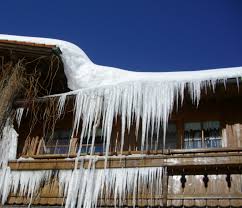What is an Ice Dam?
An ice dam is a ridge of ice that forms at the edge of a roof and prevents melting snow (water) from draining off the roof. The water that backs up behind the dam can leak into a home and cause damage to walls, ceilings, insulation, and other areas.
While frozen, the snow and ice on the roof are no more trouble than the icicles that hang down. But during the warmer parts of a winter day, water melting off the roof pools behind the ice, then seeps back up under the shingles. Sometimes water can work its way 5 – 10 ft back up under the shingles. Eventually, it drips through the roof into the soffits, walls, and worst of all, onto your ceilings. You’ll first see ice dam rust spots on drywall fasteners, then perhaps peeling paint, sagging drywall and stains around windows and doors. Insurance companies pay millions of dollars to thousands of homeowners annually to repair the damage. But it’s never enough to cover the time and aggravation of getting everything fixed. (Family Handyman https://www.familyhandyman.com/roof/prevent-ice-dams/)

There are four reasons why an ice dam forms only during certain winters:
- You have a hot attic: not enough insulation or ventilation in your attic.
- Fluctuating temperatures: slightly above freezing during the day and well below freezing during the night.
- Radiant heat from the sun: even if temperatures are below freezing both during the day and night, the sun’s radiant heat is enough to melt a portion of the ice, which then refreezes after sundown.
- Perfect Temperatures: during temperatures between 30-32 degrees, even with an energy-efficient attic, water melts and then refreezes, which is a “perfect storm” for an ice dam to occur.
How to Prevent Ice Dams
The key to preventing ice dams is simply to keep your attic and roof cold. After a snowfall, a cold roof will have a thick blanket of snow. A warmer roof, however, will soon have clear spots where the snow has melted off, and may well have icicles hanging from the eaves.
Check the depth of your attic insulation. Building codes require about 12 to 14 in. of fiberglass or cellulose. Add more if you have less than 8 in. and have had ice dam problems in the past. Blown-in cellulose and fiberglass are usually better than hand-placed batts because they fill more tightly around rafters, joists and other obstructions, leaving fewer gaps.
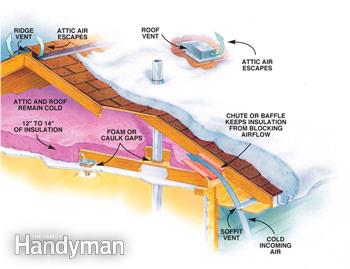
Prevention Strategies
A cold roof isn’t always a perfect solution. During winters with heavy snowfall, you may get ice dams anyway. Or ice dams may consistently form at the foot of roof valleys (the junction where two roofs meet at a right angle) because they fill with windblown snow. And some sections of the roof may be impossible to keep cold. That’s when you have to call on secondary strategies and ice dam prevention products to prevent ice dam damage.
Ice and water barrier is a type of self-sealing underlayment that adheres to the roof decking and waterproofs it. You shingle over the top of it. It’s required by the building code in most regions, including Wisconsin.
Rake the snow off your roof after a heavy snowfall. An ice dam prevention products snow rake, which is an aluminum scraper mounted at a right angle on a telescoping aluminum pole, is the simplest solution for occasional heavy snows. If you pull the snow down, it can’t melt and form an ice dam. It’s an effective, if tedious, solution, but only for single-story homes. You can’t reach the second-floor roof. (Never use a snow rake when standing on a ladder!) And you have to take care not to break the shingles, which are brittle in cold weather.
Install heat cables when all else fails. Heat cables are high-resistance wires that you mount on the roof edge in a zigzag pattern and plug into an outdoor GFCI receptacle. They’re ideal in spots where ice dams regularly occur and can’t be stopped any other way. One problem: You have to route the meltwater away. Otherwise, it’ll refreeze in the gutters and along the roof edge. You’ll have to run the heat cable inside a downspout so the downspout doesn’t clog with ice.
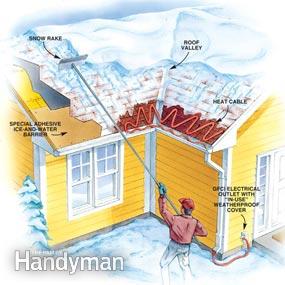
Cannot Predict Ice Dams
A homeowner or home inspector cannot predict when and where an ice dam will occur. They can, however, take precautions to avoid ice dams after a particular heavy snow or ice storm, especially when icicles build up on the eaves.
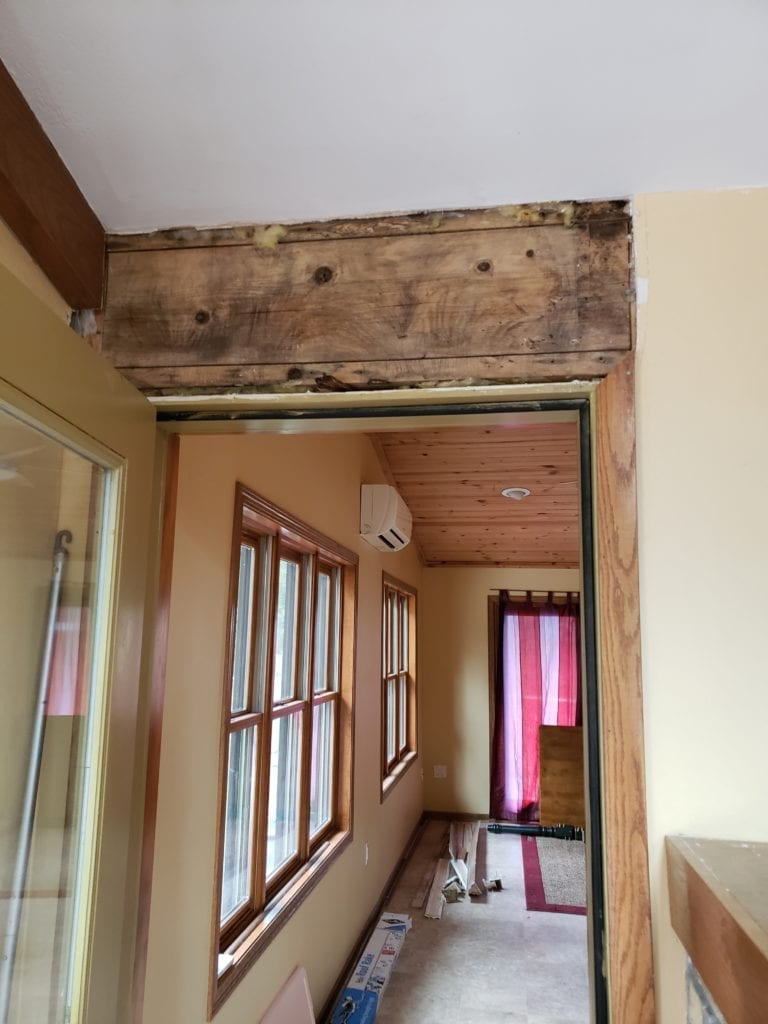
This unfortunate homeowner experienced ice dams in two planes of the roof. The repair process is lengthy and costly.
Your insurance agency will almost certainly cover the damage done to the interior after an ice dam. But typically the removal of the ice dam itself is considered to be the homeowner’s responsibility.
Insurance companies expect you to put fourth an effort to prevent ice dams by making sure you’re your home is adequately insulated, properly ventilated, all attic bypasses are sealed, and that the exterior of your home is water tight and in tiptop shape (i.e., your roof). During winters with epic amounts of snow, they throw something else on your plate that you may or not be aware of. Shoveling and/or raking your roof! Most insurance policies state in some oblique way that roof-raking or shoveling the snow off your roof is part of regular and necessary home “upkeep.”
Regardless of the extent to which you fulfill your “responsibility” to keep your roof snow-free, the insurance company most likely is still not required or obligated to pay one penny for ice dam removal.
Is an Ice Dam a Defect?
Well, yes and no. An ice dam itself is not a defect, but the damage they can cause is.
When buying or selling a house in the winter in the northern states, it is especially important to be aware of issues that can occur, especially if the house is vacant or unattended to.
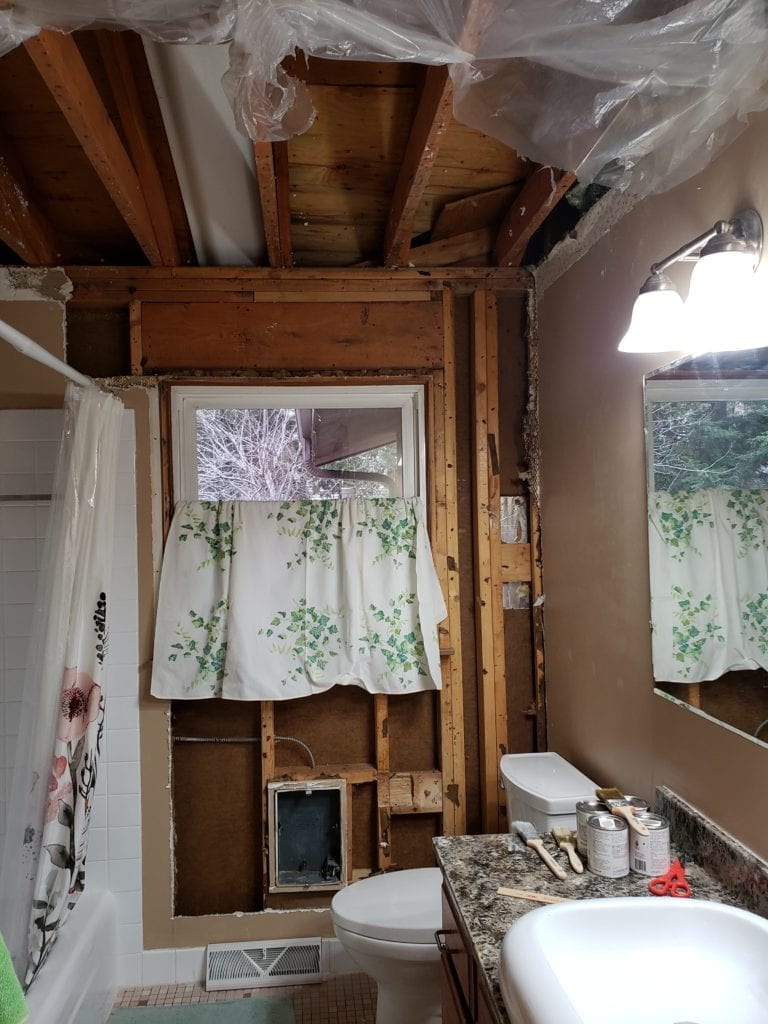
The after-effects of an ice dam is certainly cause for some remediation during the transaction. However, because no one can adequately predict if, where, or when an ice dam will occur, once the closing is completed there is less chance of remediation.
Call Premiere Stagers & Realty at 608-345-9396 for expert service.
